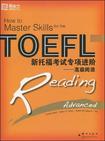新托福考试专项进阶
出版时间:2009-8 出版社:群言出版社 作者:哈尔,米尔奇,麦考马克 页数:350 译者:蔡青,刘洋
Tag标签:无
内容概要
《新托福考试专项进阶》系列丛书从托福考试所考查的听、说、读、写四项技能人手,为考生提供了详尽的考试指导,并将各技能分为初、中、高三级,逯过独特的“进阶训练”方式,再辅以大量练习,让考生逐步掌握托福实考的技巧,同时切实提高英语实际运用能力,从而在短期内轻松取得托福高分。本丛书内容编排由易到难,循序渐进,实战性强,是不可多得的托福备考资料。 本丛书引进自韩国多乐园出版社。该社成立于1977年,在韩国英语教育出版领域始终处于领军地位。本丛书被韩国众多学校和培训机构指定为课堂教材,在托福考生中享有较高声誉。
书籍目录
Contents PART 1 Basic Comprehension Unit 1 Vocabulary Biology/Sociology|Literature Unit 2 Reference Science|History|Economics Unit 3 FactuaIInformation Art/Geography|Politics Unit 4 Negative Factual Information Culture/Astronomy/Chemistry Unit 5 Sentence Simplification Ecology/Biology/Geology PART 2 Making Inferences Unit 6 RhetorlcaI Purpoae Zoology/Sociology/Literature|Language Unit 7 Inference Psychology/History/Geography Unit 8 lnsertText Art/Economics/Science PART 3 Reading to Learn Unit 9 Prose Summary Geology/Astronomy/Chemistry Unit l0 Fill in aTable Culture/Anthropology/Ecology|Biology Vocabulary Wrap-up ActuaITest 01 ActuaITest 02Contents(Answer Book) Unit 1 Vocabulary Unit 2 Reference Unit 3 Factual Information Unit 4 Negative Factual Information Unit 5 Sentence Simplification Unit 6 Rhetorical Purpose Unit 7 Inference Unit 8 InsertText Unit 9 Prose Summary Unit 10 Fill in a Table Actual Test 01 Actual Test 02
章节摘录
The principles making radio possible were developed throughout the nineteenth century. The first breakthrough was by the British physicist Michael Faraday in 1831. He discovered that when an electric current passes through one wire, it produces a current in another wire even though the wires do not touch each other. In 1864, James Maxwell showed that this current——composed of electromagnetic waves——travels at the speed of light. Heinrich Hertz proved that the waves pass through solid objects. With these discoveries in place, the race was on to develop a system of wireless radio. Among the contenders was Reginald Fessenden, a Canadian inventor. Fessenden began experimenting with radio detectors in order to explore the possibility of voice transmission. In 1900, he was the first person to transmit his voice, but the sound was unrecognizable because the waves were not continuous. He invented a barreter detector, taking its name from the French word exchanger, to receive AM (amplitude modulated) signals, but it was not sensitive enough. One day in 1901, he accidentally left a filament of wire in acid for too long until only a tip of the wire was in contact with the acid. Fessenden noticed that, with the wire in the acid, the barreter was very sensitive to nearby continuous radio waves. Fessenden called his invention a liquid barreter, but it became known as an electrolytic detector. The detector consisted of several connected parts forming an electric circuit. A silver-coated platinum wire was dipped into a small platinum cup filled with nitric or sulfuric acid and connected to the ground. A battery was connected between the wire and the acid, prompting a current to flow in the detector. Someone wearing headphones that were hooked up to the detector could hear a hissing noise, which could be adjusted by turning a dial until the hissing noise stopped. At that point, the detector was highly sensitive to incoming radio waves.
图书封面
图书标签Tags
无
评论、评分、阅读与下载
用户评论 (总计92条)
- “新托福考试专项进阶—高级阅读—..”
- 托福专项进阶系列丛书真心好使,超赞,适合the learner prepare toefl ibt test by themselves.
- 分话题对托福考试阅读进行训练,掌握各种话题相关的单词,用于托福的练习和自学都是很有效果的。而且新东方的书,一直都很不错。
- 算是基本全英文的书了,除了答案及翻译。第一次买全英文的书,本人没有考托福的打算,纯属拿来做阅读练习。书的质量非常好!是这一单三本书中最满意的了!答案只有翻译,没有解析哦!所以我觉得挑战起来还是有一点难度的。不过还是很喜欢这本书!新东方就是值得信赖!
- 首先书的质量一如既往的好,其次我之前做过新东方家之前的托福系列书,这次想再找点题练、难一定的,这本书完全符合了~做起来感觉很好~
- 很经典的托福考试学习教材,买了一套,推荐!
- 一本好的托福考试的辅导书
- 新东方的托福教程没得说了,题好量足,还有标限时,帮助很大
- 我是考完了GRE才来考托福的,感觉阅读难度不大,稍微做点题目就可以应付了
- 个人感觉,针对托福阅读的各种题型有专门的练习,而且练习的量比较大,文章也具有一定的难度。是一本不错的备考书
- 强烈建议!做完就高分!我托福29!
- 适合备考托福的人用,章节清晰,逐步增加难度,很好的书
- 建议考托福的同学,都看看这本
- 感觉托福的阅读就直接做文勇的那个就好啦 在文勇的那个没有做三遍之前是不应该做别的的。。。哇哇。。当年没人告诉我。。白买了这本了。
- 适合熟悉托福阅读题型,分类的,题量大,难度还可以
- 适合高二学习托福的学生使用
- 书的内容很好 托福必备 做题的时候要掐准时间按时完成比较有效果
- 买了很多本托福书,内容酒还没看,纸质什么都很好,包装也很好
- 对托福很有帮助的一本书,但和怔怔的托福相比稍微偏简单了一些。
- 有了这本书,托福过百分没问题!
- 托福的助手!
- 很好~备考托福必备!
- 很不错,托福必备!这套书都挺不错的!
- 还没啥看 不过对托福应该很有帮助
- 书很好,质量也很好,备考托福的精品书籍
- 用完中级再用高级,然后,滚去考试!!!
- 正是需要的,希望第一次TOEFL考试就能取得理想的成绩!
- 对于熟悉考试,做套题前训练很有帮助~
- 按题型分项练习,文章不长,用于专项练习挺好,套题少,后期还是要做套题。
- 内容设计很好,循序渐进,逐步提升,又简单到难度较大的阅读,按设计的来应该会有所提升。
- 一定要认真读,加油学英语,加油
- 还没看,不过新东方出品,买了阅读口语和写作
- 本书所选范文很地道, 不仅可以练习阅读水平,同时可以作为模仿写作的极佳参考资料.
- 新东方老师让买的,还不错吧,有点小贵
- 新东方的书一直很好。
- 里面的阅读都很有难度对我来说,正好可以锻炼自己的阅读能力,提高自己的阅读感觉。
- 从初级到高级都有它们各自的长处。这个系列的都很好。
- 这本高级阅读是老师推荐的,很好。另外,快递很给力!
- 相信通过写这些题目,自己的能力会有能力提升的
- 阅读很有帮助,又是有针对性地训练~
- 非常实用的一本书,把OG上细节的阅读分类进一步深化训练~~~建议~~
- 挺好的,不过还没用,不知道内容如何,等用了之后再追加评价。店家送了一面小国旗,灰常惊喜,谢谢,哈哈!
- 看得别人的经验帖子里的,内容看了下,很丰富,努力学习中。
- 几乎大部分内容都是针对题型去归类分析,全套的题只有很少,不过如果想做针对性的练习就很适合,想练手的就不要买了。
- 很好的学习书,实用性强。
- 很好的书,循序渐进
- 听好的听好的
- 挺满意的,编排地不错,送地也快,一定会有帮助的!
- 难度适中,亮点在于每篇文章下对生难词英英的示意。答案部分的翻译也很不错。是本好书。
- 针对阅读所出的一本备考书,印刷质量不错,内容也不错。
- 质量好 内容也好 阅读量很大
当当也很便宜 - 好,练习用!
- 编写专业 很适合练习使用
- 正是我要的 分类练习
- 里面分各种类型的练习,还是很不错的,难度适中
- 很好,学校用的教科书,好评
- 内容不错,适合学习。
- 读了 真好 真好
- 该书有一定的难度,普通水平的学员读起来会比较吃力。
- 儿子说能帮助系统复习
- 好书,如果把这套书熟练的掌握了,那你就成功了
- 提高自身单词量,提高语法,
- 书有用,阅读重点都讲到了。
- 包装的很严实,以前买过写作的挺好的,希望阅读的也有帮助~
- 阅读使人开阔
- 阅读材料受益匪浅
- 买了中级阅读……觉得还不错~
- 快递很好,商家诚实,教材实惠
- 挺好的教材。初中高顺下来挺有收获的。
- 好书用帮助正在使用中
- 比想象中还好
- 还没看,大致翻了下,内容详实
- 这本书对我的帮助很大,内容真心不错
- 内容和纸张的质量都好。
- 朋友推荐的,书的质量很好,内容 很有针对性。
- 内容充实,难度适宜
- 大概看了一下 书的质量非常好 看着就很舒服 具体内容还没有看
- 包装很好,纸质也不错,内容还没有看
- 内容很好 记得要按时间完成
- 内容喜欢,在书店看了就想买,没想到当当很便宜,很喜欢
- 书很大,有很多练习题,很喜欢,内容是全英文的
- 昨天拿到书,先大概的翻看了一下,内容非常好!
- 商品不错,忘了分享了
- 还不错,不过文章词汇量比较大,难度高
- 这本还没开始做。。不错的书
- 很实用、还可以帮助分析结构
- 十分有作用,有一定的难度
- 还不错。推荐
- 额~~~~~~
- 希望对英语学习有一定的好处
- 读新东方新托福考试专项进阶高级阅读后感
- 托福阅读
推荐图书
- 外汇短线交易的24堂精品课
- 王樣老師 2
- 王样老师 3
- 王样老师 4
- HERE COMES EVERYBODY此即人人
- 龙的文化解读
- 女书文化研究
- 追求卓越
- 复杂群决策系统决策与协同优化
- 新中国成立初期中国共产党社会救助思想与实践研究
- 霍姆斯现实主义法学思想研究
- 相图边界理论及其应用
- 英汉-汉英水污染科学词汇
- 高分新托福全真模拟120
- 微分几何
- 经济数学基础·微积分
- 高等数学(上)
- 高等数学(下)
- 高可用存储网络关键技术的研究
- 魅力魔方
- 五笔字型每分钟打100字最快练成独家秘籍
- 世界一流大学与科研机构学科竞争力评价研究报告2009
- 开城安西王府遗址勘探报告
- 乳酸菌与乳品发酵剂
- 中国至2050年能源科技发展路线图
